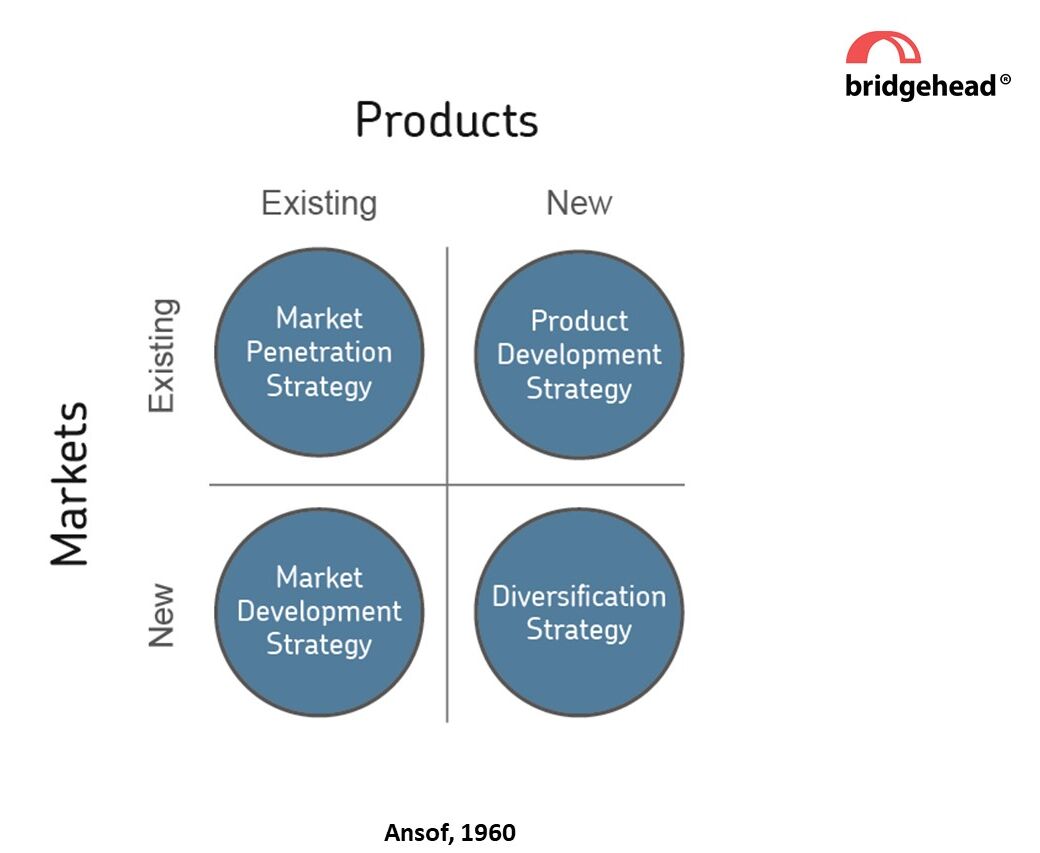Interested in growing your business? There are a variety of ways to do so; but how do you know which strategy is right for your venture? A market product grid helps companies plot out their growth strategy and visualize the risks associated with expansion.
It can help key leaders make decisions around product development, distribution, marketing, and even hiring. The matrix (see image below) was initially published by Harvard Business Review. It has since become a core teaching at business schools all over the world. In this article we cover what you need to know about a market product grid, and how to use one to initiate your growth strategy.

What is a market product grid?
A market product grid is also known as an Ansoff Matrix or a product-market expansion grid. It is a tool that businesses use to develop a growth strategy. Market product grid considers new and existing markets, new and existing products, and the risks of each possible relationship.
The market product grid divides strategic outcomes by four major categories:
- Market penetration: a business creates growth by bringing its current products to existing markets
- Market development: a business creates growth by bringing its current products to new markets
- Product development: a business creates growth by bringing new products into existing markets
- Diversification: a business tries to create growth by bringing new products to new markets
Why use a market product matrix? The goal is for the company to plan its existing products and new products – as well as where they’re going to sell each product – and learn about the risk associated with their plan. The grid is best used to understand your business growth options, but it won’t tell you what actions you should take.
How to make a market product grid?
The simplest market product grid uses two axes: the x-axis for products (new and existing), and the y-axis for markets (new and existing). To use the matrix effectively, business leaders must have a firm understanding of where the best opportunities lie given the company’s current position. Recognise how many resources you can expend, as well as what your risk tolerance is.
1. Market penetration
Typically, strategic leaders start in the market penetration quadrant, where they’re bringing an existing product to an existing market. This quadrant is considered the most obvious starting point for any company: it attempts to gain market share in an existing market. This approach “does not require the company to venture into unexplored markets and products. As a result, it provides a lower amount of risk because essentially the organization’s scope remains unchanged.”
2. Product development
However, sometimes increased competition or economic and legal constraints prevent a company from pursuing further market penetration. In these instances, a company might choose to pursue product development: bringing a new product to an existing market. This strategy is one level up on the risk scale. It involves diversifying to new products, but not to new markets; often, companies mitigate this risk by using the same core technology, instead of developing entirely new products. Likewise, this strategy is likely to be more expensive as new talent and tools may be needed to create a new product.
3. Market development
Some companies prefer to forgo product development in favour of a market development approach. Market development, bringing an existing product to a new market, requires an effort in planning and customer research. But it doesn’t need to be so complicated. To simplify, a new market can be tapped by:
- Distributing to a new geographical area;
- Implementing new pricing to attract a new customer set;
- Or, developing new distribution channels.
4. Diversification
Lastly, the riskiest growth strategy for a company is full diversification: bringing a new product to a new market. This risk, however, can be offset by the potential gains. Diversification inoculates a company against economic upheaval; when one market fails, or one product goes out of style, the company is protected. Diversification may have the highest investment in terms of research, distribution, and marketing, but it can pay off big-time.
What growth strategy is right for your business?
In conclusion, the product market grid will help you answer what growth strategy is right for you. However, strategic leaders must factor in costs, risk, and their type of product or customer. A manufacturing or distribution partner can help alleviate some of the burden of expanding into a new market. Mature businesses will have different risk tolerances than a start-up, and depending on your industry, it can be hard to find a place that isn’t already fiercely competitive. Do your market research to learn more.
This article originally appeared on Gembah and has been posted here with their kind permission.
Insights on international expansion
If you enjoyed our top tips for new exporters, join our Discovery Lite portal for free. You’ll get access to a monthly insights magazine and bonus downloadable materials to help your business reach new markets:
Related content
Let’s connect













